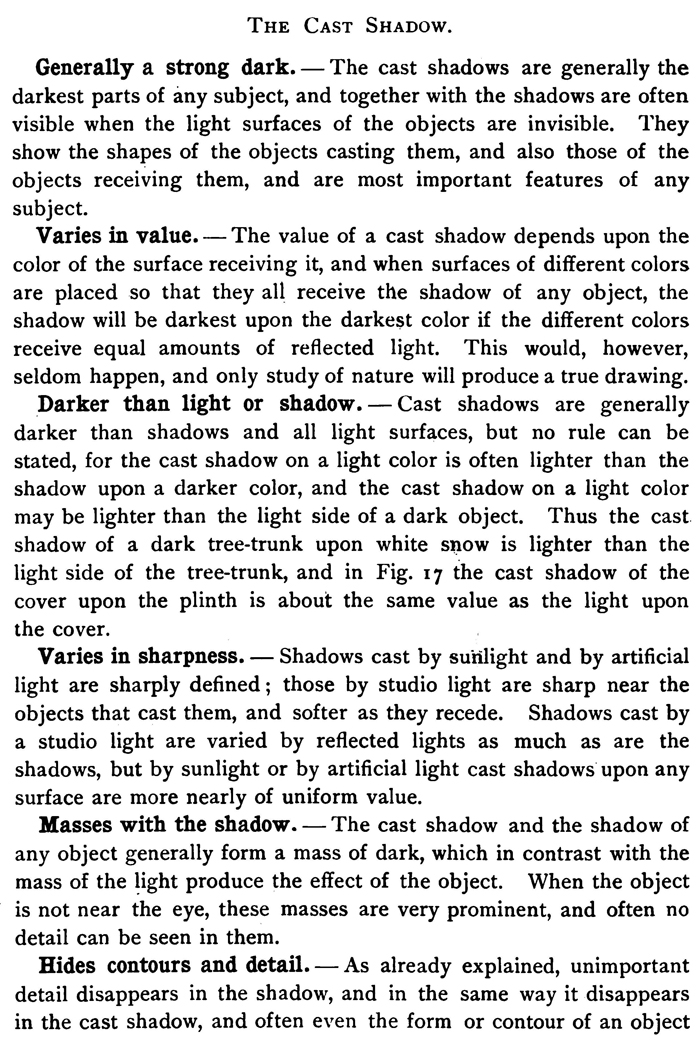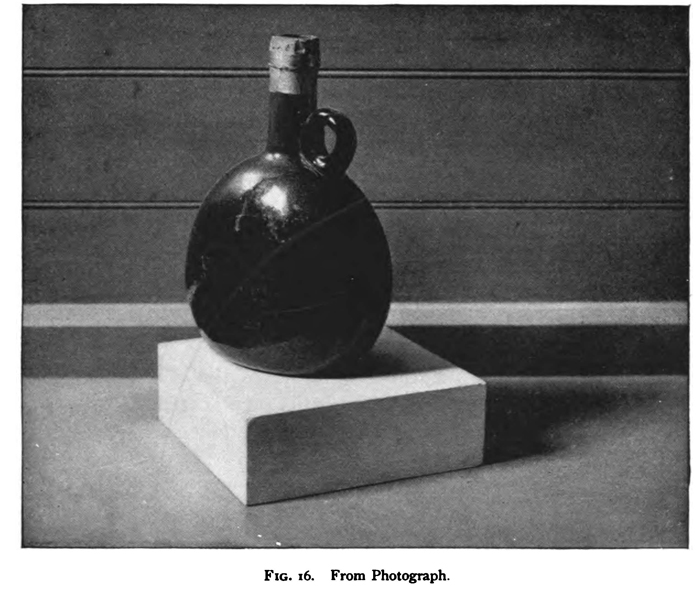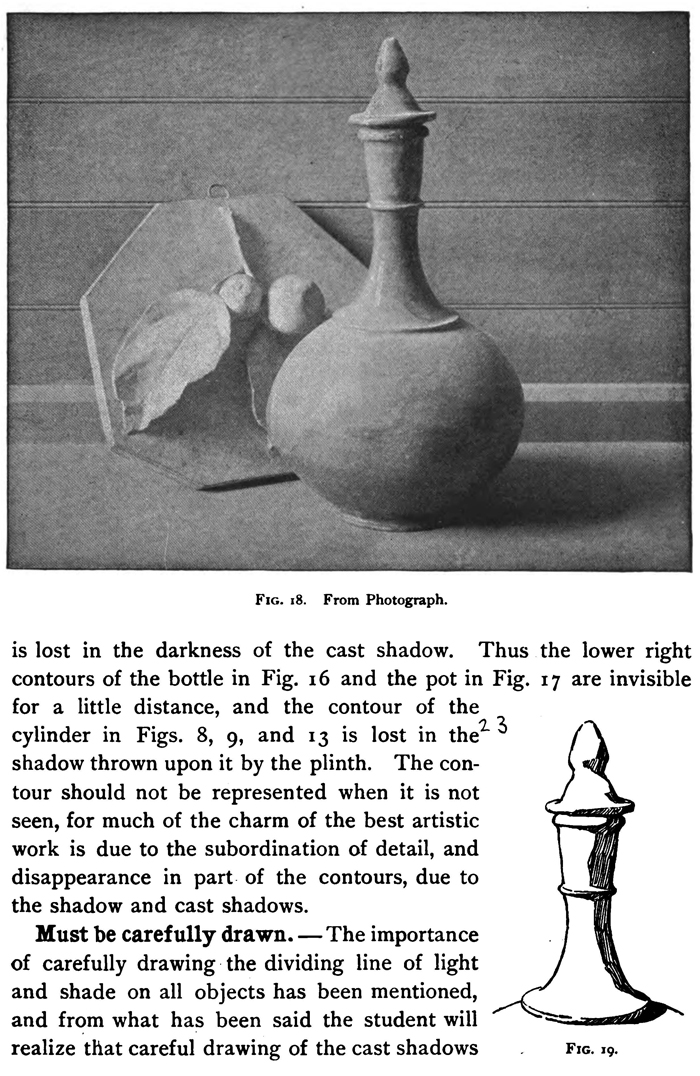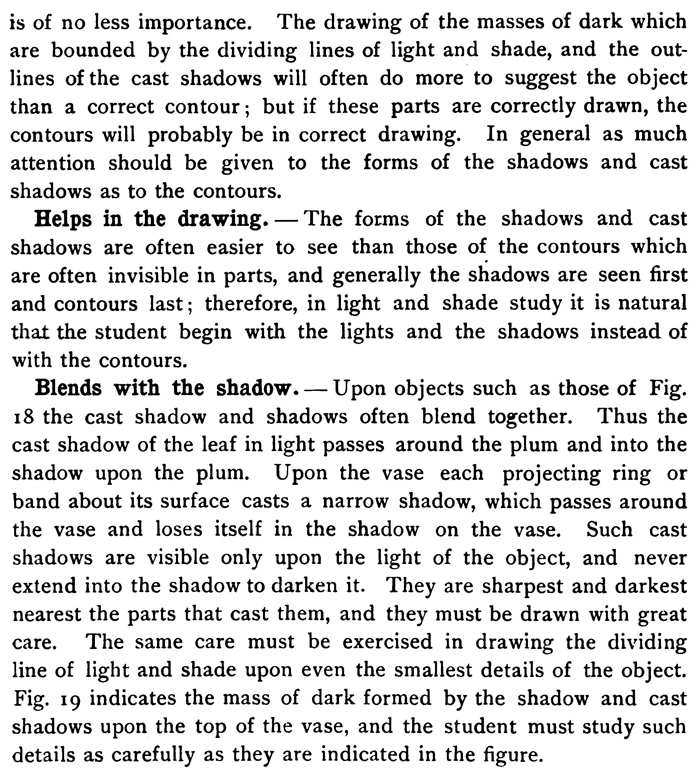Home > Directory of Drawing Lessons > How to Improve Your Drawings > Drawing Lights and Shadows > How to Draw Cast Shadows
Drawing Cast Shadows : Learn How to Draw the Casting of Shadows with the Following Shading Tutorial
|
|
THE CAST SHADOW.Generally a strong dark.The cast shadows are generally the darkest parts of any subject, and together with the shadows are often visible when the light surfaces of the objects are invisible. They show the shapes of the objects casting them, and also those of the objects receiving them, and are most important features of any subject. Varies in value.The value of a cast shadow depends upon the color of the surface receiving it, and when surfaces of different colors are placed so that they all receive the shadow of any object, the shadow will be darkest upon the darkest color if the different colors receive equal amounts of reflected light. This would, however, seldom happen, and only study of nature will produce a true drawing. Darker than light or shadow.Cast shadows are generally darker than shadows and all light surfaces, but no rule can be stated, for the cast shadow on a light color is often lighter than the shadow upon a darker color, and the cast shadow on a light color may be lighter than the light side of a dark object. Thus the cast shadow of a dark tree-trunk upon white snow is lighter than the light side of the tree-trunk, and in Fig. 17 the cast shadow of the cover upon the plinth is about the same value as the light upon the cover. Varies in sharpness.Shadows cast by sunlight and by artificial light are sharply defined ; those by studio light are sharp near the objects that cast them, and softer as they recede. Shadows cast by a studio light are varied by reflected lights as much as are the shadows, but by sunlight or by artificial light cast shadows upon any surface are more nearly of uniform value. Masses with the shadow.The cast shadow and the shadow of any object generally form a mass of dark, which in contrast with the mass of the light produce the effect of the object. When the object is not near the eye, these masses are very prominent, and often no detail can be seen in them. Hides contours and detail.As already explained, unimportant detail disappears in the shadow, and in the same way it disappears in the cast shadow, and often even the form or contour of an object is lost in the darkness of the cast shadow. Thus the lower right contours of the bottle in Fig.16 and the pot in Fig. 17 are invisible for a little distance, and the contour of the cylinder in Figs. 8, 9, and 13 is lost in the shadow thrown upon it by the plinth. The contour should not be represented when it is not seen, for much of the charm of the best artistic work is due to the subordination of detail, and disappearance in part of the contours, due to the shadow and cast shadows. Must be carefully drawn.The importance of carefully drawing the dividing line of light and shade on all objects has been mentioned, and from what has been said the student will realize that careful drawing of the cast shadows is of no less importance. The drawing of the masses of dark which are bounded by the dividing lines of light and shade, and the outlines of the cast shadows will often do more to suggest the object than a correct contour ; but if these parts are correctly drawn, the contours will probably be in correct drawing. In general as much attention should be given to the forms of the shadows and cast shadows as to the contours. Helps in the drawing.The forms of the shadows and cast shadows are often easier to see than those of the contours which are often invisible in parts, and generally the shadows are seen first and contours last ; therefore, in light and shade study it is natural that the student begin with the lights and the shadows instead of with the contours. Blends with the shadow.Upon objects such as those of Fig. i8 the cast shadow and shadows often blend together. Thus the cast shadow of the leaf in light passes around the plum and into the shadow upon the plum. Upon the vase each projecting ring or band about its surface casts a narrow shadow, which passes around the vase and loses itself in the shadow on the vase. Such cast shadows are visible only upon the light of the object, and never extend into the shadow to darken it. They are sharpest and darkest nearest the parts that cast them, and they must be drawn with great care. The same care must be exercised in drawing the dividing line of light and shade upon even the smallest details of the object. Fig. 19 indicates the mass of dark formed by the shadow and cast shadows upon the top of the vase, and the student must study such details as carefully as they are indicated in the figure. |
Privacy Policy ...... Contact Us











